©
2004 Jeff Matthews & napoli.com
Gaeta
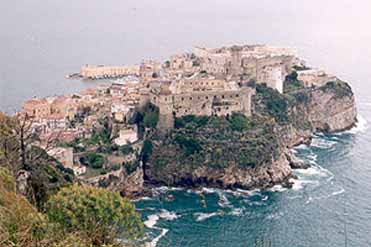
I have
not spent much time in Gaeta, about 60 miles north of Naples. I recall
that it has fine beaches and a picturesque waterfront. It is also an
important military naval port. As the northernmost coastal city in the
old Kingdom of the Two Sicilies (Naples), Gaeta does have some interesting
episodes connected with it. It is probably most familiar for the fact
that it was the site of the last stand by the Bourbon army against the
Italian forces of Victor Emanuel II. After leaving Naples, the last
defenders of the Neapolitan Bourbon dynasty took refuge in the fortress
of Gaeta (photo) and withstood a siege and withering bombardment that
lasted from November 1860 to February 1861, at the end of which they
surrendered, and the modern nation-state of Italy was born. (See, also,
the entry on Maria Sophia of Bourbon.)
But there
is another episode, not too many years before that and also connected
with the political movement to unify Italy. In the "What-If" game of
history—always as delightful as it is irrelevant—the unification
of northern and southern Italy into a single state perhaps did not have
to unfold the way it did. What if King Ferdinand II of Naples had sent
forces in 1848 to join the northern armies in the First War of Italian
Unification, a campaign to liberate parts of northern Italy from Austria?
That might have brought about an Italian confederation of sorts with
no invasion of the south necessary at all a decade later.
Actually,
Ferdinand did, indeed, send an army to join the battle against Austria,
but he recalled it. There are a number of reasons for that, foremost
of which is that he knew that an Italian confederation would be setting
up the eventual invasion of the Papal States, the large chunk of church
land in central Italy that effectively stood in the way of unifying
the peninsula. Ferdinand was not prepared to be part of that eventual
invasion. Also, Pope Pius IX had refused to commit Papal forces and
moral support to the campaign against the Catholic nation of Austria.
(Obviously, the Pope also realized that a united Italy would sooner
or later mean the end of the Papal States and the 1000-year-old "temporal
power" of the Vatican.) Thus, Ferdinand withdrew the forces of Naples
from the war, and the north went it alone in 1848 and took a beating.
(Again
in the What-If game, Ferdinand's son, Francis II, took the throne of
Naples a decade later and refused a similar chance to form a coalition
with King Victor Emanuel of Savoy, who proposed an Italian peninsula
shared by two separate states, north and south, plus a smaller version
of the Church State. That was the last chance to obviate Garibaldi's
invasion of the Kingdom of the Two Sicilies.)
Part of
the broad revolutionary conflicts that swept Italy—indeed, much
of Europe—in 1848 was the proclamation of the Roman Republic.
It was the result of a successful uprising, fomented by Mazzini's Young
Italy movement, to overthrow the Pope (not as the head of the faith,
but as the king of the Church State). The Republic lasted, officially,
from February 9 to July 3, 1849 but Pope Pius IX had left Rome in November
of the previous year to escape possible violence against his person.
(Republican agitators had already murdered the Pope's Prime Minister).
The Pope went to Gaeta, where he was under the protection of the king
of Naples. From his refuge in Gaeta, Pius IX called on the Catholic
nations of Europe to help restore him to his See and to restore the
temporal power of the Church, which the Republicans had declared defunct
in one of their first proclamations.
That is
precisely what happened. A broad coalition of Neapolitan, French, Austrian,
and even Spanish troops (who landed at Gaeta) surrounded the Roman Republic,
and not even the resourceful Garibaldi (involved in the defense of the
city) could hold out against all that. The fighting was furious, but
the outcome was never in doubt. The Pope returned to Rome in April of
1850 where he and his state would be protected by French troops until
1870 when Rome finally succumbed to the forces of the new Italy.
The Church
of San Francesco in Gaeta was built (on the site of an earlier monastery)
by Ferdinand II to honor the brief presence of the Pope in Gaeta. As
well, the San Martino museum in Naples has on display a painting by
the Flemish artist, Frans Vervloet showing "The Pope Greeting the Multitudes
in Gaeta". For a short time, then, I guess Gaeta was the seat of the
Roman Catholic Church.
Samnites
Samnium, the Little Empire that Couldn't
| From
the 6th to 4th centuries b.c. Samnium spread from coast to coast
in central Italy. This map is on the belfry in the main street of
the city of Benevento, the ancient capital of Samnium. |
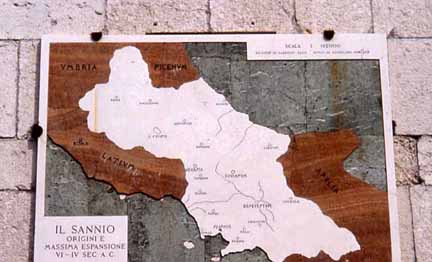 By the year 1000 b.c. the great Indo-European migrations
had spread along a broad front all the way from northern India to the
Mediterranean and Western Europe, leaving in place on the Italian peninsula
dozens of related tribes: Apuli, Lucani, Umbri, Campani, Marsi, Volsci,
Falisci, Hernici, and so forth. Some of them are still remembered in
geographical names on the map of modern Italy, and one of them, in particular,
stands out: the Latini, a portion of whom by two or three hundred years
into the millennium had settled on the Tiber river. Much later, when
these "Romans," as victors always do, wrote the history of their conquests,
they hung condescending tags on many other peoples of the peninsula
—the Fat Etruscans, the Undemanding Umbrians, and so on.
To at least one people, however, the Romans affixed a term that showed
respect, even fear: belliger Samnis, the Warrior Samnites. [For
a separate item on "The Ancient Peoples of Italy," click here.] By the year 1000 b.c. the great Indo-European migrations
had spread along a broad front all the way from northern India to the
Mediterranean and Western Europe, leaving in place on the Italian peninsula
dozens of related tribes: Apuli, Lucani, Umbri, Campani, Marsi, Volsci,
Falisci, Hernici, and so forth. Some of them are still remembered in
geographical names on the map of modern Italy, and one of them, in particular,
stands out: the Latini, a portion of whom by two or three hundred years
into the millennium had settled on the Tiber river. Much later, when
these "Romans," as victors always do, wrote the history of their conquests,
they hung condescending tags on many other peoples of the peninsula
—the Fat Etruscans, the Undemanding Umbrians, and so on.
To at least one people, however, the Romans affixed a term that showed
respect, even fear: belliger Samnis, the Warrior Samnites. [For
a separate item on "The Ancient Peoples of Italy," click here.]
If you
head into the rugged terrain east of Naples, to Benevento, you enter
an area called Safinim by its Oscan-speaking inhabitants of 500
b.c. and Samnium by Latin-speaking neighbors a few hundred miles
to the north. Today, you will notice something very interesting on the
tower in the main street. On one side there is a map of the Duchy of
Benevento, the Lombard state that lasted from the fall of the Roman
Empire to the coming of the Norman Kingdom
of Naples in the 11th century. On the other side of the tower is a map
of pre-Roman Samnium. There is nothing, whatever, to tell us that the
area was ever part of anything called The Roman Empire. This "oversight"
is, perhaps, a holdover from enmity that led to long bloody wars and
even genocide, before this tough race of mountain warriors, the Samnites,
in their stand against Rome, eventually went the way of the Etruscans,
Greeks, and Carthaginians.
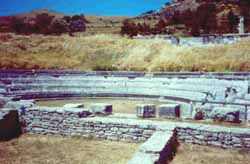 The
Samnites were immigrants to the area, replacing the Opici (or
Osci--Oscans), who, however, have given their name to the large
family of languages spoken by many Indo-European inhabitants of Italy
at the time, including the Samnites, the Sabines to the north of Rome,
and the Campanians of this area. Oscan was related to Latin as, approximately,
Spanish is to Italian, or English to German. The Samnites, themselves,
had no written language until 425, when they penetrated western Campania
and came in contact with the Greeks of Neapolis and subsequently adopted—and
adapted—the Greek alphabet. The
Samnites were immigrants to the area, replacing the Opici (or
Osci--Oscans), who, however, have given their name to the large
family of languages spoken by many Indo-European inhabitants of Italy
at the time, including the Samnites, the Sabines to the north of Rome,
and the Campanians of this area. Oscan was related to Latin as, approximately,
Spanish is to Italian, or English to German. The Samnites, themselves,
had no written language until 425, when they penetrated western Campania
and came in contact with the Greeks of Neapolis and subsequently adopted—and
adapted—the Greek alphabet.
Setting
aside the special cases of the earlier Etruscans and Greeks, 400 b.c.
marks the beginning of various attempts by competing peoples in Italy
to gain an upper hand. At that time, Samnium was already made up of
a Samnite League of four peoples, the Caudini, Hirpini,
Caraceni and Pentri, and their territory was bigger than
any other contemporary state in Italy. Although these people were generally
landlocked between the mountains in today's eastern Campania and the
plains of Puglia on the other side of the peninsula, at the point of
their maximum expansion they actually controlled coastlines on both
sides. They were bounded by Lucania in the south and Latium
in the north. The first official dealing between the Samnites and Romans
that we know of was a treaty they signed in 354 b.c., most likely a
pact in the face of what were still formidable threats from the Etruscans
as well as the ferocious Celts, who had sacked Rome a few years earlier.
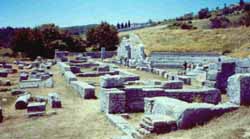 By
the middle of the 4th century the Romans were already enjoying some
local success at consolidation. In 338 they had dissolved the Latin
League, making other member peoples part of the Roman state in what
had now become a Greater Latium of sorts. To the south, however, they
were totally unable to play the sister peoples of Samnium off against
one another. The Samnites were resistant to the outside world and content
to hole up in the mountains, building their characteristic polygonal
fortifications on the heights and living in a social system based on
tribal communities. They hunted and herded, existing—subsisting—on
the sparse soil and by barter. As warriors, their army was organized
into cohorts and legions, much like the Romans, and they also used cavalry.
Some speculate that the Romans borrowed the idea of those gruesome gladiatorial
fights to the death from the Samnites, who at the time of their first
face-offs with Rome already had the reputation of being merciless fighters
who took no prisoners. By
the middle of the 4th century the Romans were already enjoying some
local success at consolidation. In 338 they had dissolved the Latin
League, making other member peoples part of the Roman state in what
had now become a Greater Latium of sorts. To the south, however, they
were totally unable to play the sister peoples of Samnium off against
one another. The Samnites were resistant to the outside world and content
to hole up in the mountains, building their characteristic polygonal
fortifications on the heights and living in a social system based on
tribal communities. They hunted and herded, existing—subsisting—on
the sparse soil and by barter. As warriors, their army was organized
into cohorts and legions, much like the Romans, and they also used cavalry.
Some speculate that the Romans borrowed the idea of those gruesome gladiatorial
fights to the death from the Samnites, who at the time of their first
face-offs with Rome already had the reputation of being merciless fighters
who took no prisoners.
These were
two stubborn peoples on a collision course. In retrospect, the Romans
were more expansive (the irresistible force) and the Samnites more interested
in digging in (the immovable object). Eleven years after the signing
of the treaty, the first Samnite War broke out. It was over land in
Campania. After two years of fighting it was a standoff, and the combatants
agreed to renew their earlier pact. Rome, however, had gained northern
Campania in the deal and become as big as Samnium.
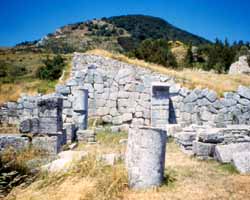 The
real struggle for the future of the peninsula began in 327 when the
Samnites took over Naples with the help of an internal Samnite faction.
The treaty between Naples and Rome swiftly brought the future empire
builders into the fray, and for six years the second war between Rome
and Samnium see-sawed back and forth in a series of indecisive border
raids. In 321 the Romans tried to break the stalemate by heading into
the heart of Samnium towards its most important city, Malventum (later
rechristened "Beneventum" by the Romans, changing the name of the town,
thus, from "ill wind" to "good wind"). They marched straight into an
ambush at the Caudine Forks near there. They were bottled up at both
ends of a valley and picked to pieces by the Samnites on the slopes.
The Romans surrendered and were disarmed and humiliated by being made
to pass beneath an arch, or yoke, as a symbol of their defeat. It was
one of the most devastating defeats in the annals of Roman military
history, and 2,300 years later the memory of it is still fresh in the
modern Italian expression, le forche Caudine, as in "that was
his Caudine Forks"—his downfall, his Waterloo, to use another
appropriate military metaphor. The Samnites, however, despite their
bloodthirsty reputation, let their Roman prisoners go in exchange for
Rome abandoning its colonies on the border of Samnium. (The Samnites
would later discover that it doesn't pay to be nice to sore losers.) The
real struggle for the future of the peninsula began in 327 when the
Samnites took over Naples with the help of an internal Samnite faction.
The treaty between Naples and Rome swiftly brought the future empire
builders into the fray, and for six years the second war between Rome
and Samnium see-sawed back and forth in a series of indecisive border
raids. In 321 the Romans tried to break the stalemate by heading into
the heart of Samnium towards its most important city, Malventum (later
rechristened "Beneventum" by the Romans, changing the name of the town,
thus, from "ill wind" to "good wind"). They marched straight into an
ambush at the Caudine Forks near there. They were bottled up at both
ends of a valley and picked to pieces by the Samnites on the slopes.
The Romans surrendered and were disarmed and humiliated by being made
to pass beneath an arch, or yoke, as a symbol of their defeat. It was
one of the most devastating defeats in the annals of Roman military
history, and 2,300 years later the memory of it is still fresh in the
modern Italian expression, le forche Caudine, as in "that was
his Caudine Forks"—his downfall, his Waterloo, to use another
appropriate military metaphor. The Samnites, however, despite their
bloodthirsty reputation, let their Roman prisoners go in exchange for
Rome abandoning its colonies on the border of Samnium. (The Samnites
would later discover that it doesn't pay to be nice to sore losers.)
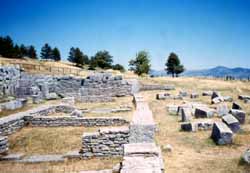 The
Romans spent the next five years signing treaties with southern Italian
peoples, such as the Lucani, ensuring that in future conflicts Samnium
would be surrounded. The Romans also rearmed, and hostilities in this
Second Samnite War resumed in 316. Samnium thrust towards Rome, putting
that city, itself, under threat of invasion. This was more or less the
highwater mark of Samnium. Their attention was diverted, however, by
Roman victories in the south and by a no-show on the battlefield by
Samnium's potential allies from the north, the Etruscans. Peace broke
out in 304. The Samnites returned to their mountain fortress, but they
remained very powerful and unyielding foes. The
Romans spent the next five years signing treaties with southern Italian
peoples, such as the Lucani, ensuring that in future conflicts Samnium
would be surrounded. The Romans also rearmed, and hostilities in this
Second Samnite War resumed in 316. Samnium thrust towards Rome, putting
that city, itself, under threat of invasion. This was more or less the
highwater mark of Samnium. Their attention was diverted, however, by
Roman victories in the south and by a no-show on the battlefield by
Samnium's potential allies from the north, the Etruscans. Peace broke
out in 304. The Samnites returned to their mountain fortress, but they
remained very powerful and unyielding foes.
Round 3
began a few years later. The last great threat to potential Roman domination
of the peninsula came at the battle of Sentinum, near modern Ancona,
in 295. Again, the allies of Samnium were elsewhere when it counted—yet
the Samnites came close. It was a massive battle, in which a Samnite
victory might have changed the history of Western civilization. "Coming
close," however, counts in horseshoes—not at Marathon or
Gettysburg. After 290, the Samnites were never again a match for the
Romans, and that date traditionally marks the beginning of true Roman
expansion.
What is
commonly called the "Pyrrhic War" was also a fourth Samnite War. It
lasted from 284 to 272 and entailed Pyrrhus of Epirus coming to Italy
to protect the enclaves of Magna Grecia from the ambitious Romans. The
Romans, themselves, viewed the affair as more than just another Samnite
war because now other peoples on the peninsula were resisting the looming
Roman hegemony. The Samnites sided with Pyrrhus, who, however, went
home after paying a prohibitively high price for a victory at Beneventum.
He has left us the expression "Pyrrhic victory," shorthand for, "With
victories like this, who needs defeats?!" He also left the Samnites
holding the bag. Their league was dismembered and they were made officially
"allies of Rome," itself Roman shorthand for, "We don't trust you enough
to make you Roman citizens, but you belong to us." The mountain warriors
were now rapidly heading for the footnotes of history.
When Hannibal
invaded Italy, the Samnites were split among themselves on whether or
not to help him help them get rid of the Romans. Indeed, the first defeat
of Hannibal on Italian soil was actually inflicted by an army of Samnite
soldiers in 217; yet, Samnium continued to be regarded by the Romans
as hostile, and potential trouble. The Samnites later confirmed this
by joining all the wrong sides in the Social War and the Civil War,
the enormous civil disorders at the beginning of the first century b.c.
As with Hannibal and Pyrrhus, the Samnites had again picked losers,
and in doing so incurred the wrath of the winners, principal of whom
was the Samnite-hating Roman general, Livius Cornelius Sulla.
In the
year 82 b.c. the history of the Samnites as a historically distinct
people came to an end when Sulla decided on a "final solution". He felt
that Rome would never know peace as long as a cohesive Samnite people
existed. He led a campaign into the mountains of Samnium to root out
and exterminate the Samnites wherever he found them. Then he defeated
them at one last pitched battle and slaughtered the thousands of Samnite
prisoners. The remaining inhabitants of Safinim were dispersed.
As a historical
curiosity, plays in the language of the Samnites, Oscan, were still
put on in Rome as late as the first century a.d. Also, Oscan writers
are said to have strongly influenced the great flair for satire in Latin
literature. There are, today, even some apparent Oscan influences in
modern Italian. There is a Samnite museum in Benevento and a formidable
archaeological site (photos, above) at Pietrabbondante, still a remote
town on the northern heights. But it isn't much, really, to remind us
of a people who once gave the future Caesars a real run for their money,
and of whom the Roman historian Livy respectfully wrote, "only death
could conquer their resolution".
Agriturismo—
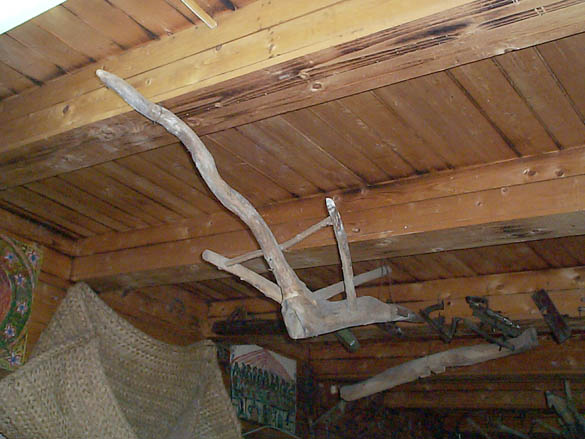 Agriturismo
is not what it used to be. Throughout Italy, that term refers to the
small off-the-beaten-track farm partially converted to an inn, a place
for guests to wander in, enjoy a home-cooked country meal, stay a night
or two, and maybe even go out and look at the horses and goats. This
combination of dude ranch and bed-and-breakfast remains most common
in central Italy, but over the last 15 years in the idyllic setting
of, say, the hills of the Sorrentine peninsula or in the Cilento region
south of Salerno, the idea has taken hold—the small country
road, the farmhouse, the orchards, the old wooden mill out in front
for display with other antique farm tools handed down from the proprietor's
father and his father before him (photo). Indeed, I have stayed in such
places, myself. They really do exist. Agriturismo
is not what it used to be. Throughout Italy, that term refers to the
small off-the-beaten-track farm partially converted to an inn, a place
for guests to wander in, enjoy a home-cooked country meal, stay a night
or two, and maybe even go out and look at the horses and goats. This
combination of dude ranch and bed-and-breakfast remains most common
in central Italy, but over the last 15 years in the idyllic setting
of, say, the hills of the Sorrentine peninsula or in the Cilento region
south of Salerno, the idea has taken hold—the small country
road, the farmhouse, the orchards, the old wooden mill out in front
for display with other antique farm tools handed down from the proprietor's
father and his father before him (photo). Indeed, I have stayed in such
places, myself. They really do exist.
Or did.
The carabiniere corps known as NAS (Nucleo Antisofisticazione)
is in charge of quality control of products meant for human consumption.
They are the ones that check the chemicals in food, the purity of drinking
water, the hygienic conditions in slaughterhouses, etc. In places that
take guests, NAS also checks the hygienic and safety conditions.
NAS has just issued a report on the state of agriturismo in Italy.
The news is not good. Of the 617 establishments checked, 184 of them
had violations, some of them serious enough to warrant punitive legal
action. Violations were disproportionately high in southern Italy—Campania,
Abruzzo, and Calabria—and included faulty sanitation, improper
ratio of guests to available space, lack of safety measures, poor conservation
of food and improper slaughtering of animals for meat.
A number
of establishments did not even seem to be agriturismo in the
accepted sense of the term. They were little more than restaurants or
hotels that had decided to cash in on our societal yearning for—and
lemming-like summer rush to return to—the good old days. These
places were by a main road, say, and just decided to hang their agriturismo
shingle on that one tree out in the parking lot. I have not given up
on the quest for the perfect, small family-farm with the authentic cheese,
wine and bread, the one with the scythe from 1840 mounted over the fireplace.
Nor should you give up, but if it has a blinking neon sign, alternating
blue and yellow for "agri-" and "-turismo," keep driving.
Bourbons
(9)
Maria
Sophia, the Last Queen of Naples
 Victors write the history books and inevitably give
short shrift to the losers. In this case, the victors—the unifiers
of Italy in the years 1860-70—have described that process as an
unstoppable fulfillment of Italian destiny. They certainly have not
spent much time on one loser, Maria Sophia (1841-1925), the last queen
of Naples, a woman whose life reads like one of those novels that young
girls—maybe in 1900—used to read furtively in convent boarding
schools late at night when the nuns thought everyone was asleep. Victors write the history books and inevitably give
short shrift to the losers. In this case, the victors—the unifiers
of Italy in the years 1860-70—have described that process as an
unstoppable fulfillment of Italian destiny. They certainly have not
spent much time on one loser, Maria Sophia (1841-1925), the last queen
of Naples, a woman whose life reads like one of those novels that young
girls—maybe in 1900—used to read furtively in convent boarding
schools late at night when the nuns thought everyone was asleep.
By the
age of 19, Maria Sophia had been a queen, lost her kingdom, rallied
soldiers around her in the hopeless defence of a lost cause, and had
had men —even her enemies—writing reams of romantic slush
about her. She was "the angel of Gaeta" who would "wipe your brow if
you were wounded or cradle you in her arms while you died". D'Annunzio
called her the "stern little Bavarian eagle" and Marcel Proust spoke
of the "soldier queen on the ramparts of Gaeta". She was intelligent,
lovely, and headstrong; she could ride a horse and defend herself with
a sword. She was everything you could ask for—a combination
of Amazon and Angel of Mercy.
Maria Sophia
was from the royal Bavarian house of Wittelsbach and was the younger
sister of the better-known Elizabeth ("Sissi") who married Emperor Franz
Joseph I of Austria. In 1859 Maria Sophia married Francesco II of Bourbon,
the son of Ferdinand II, King of Naples. Within the year, with the death
of the king, her husband ascended to the throne and Maria Sophia gave
up the frivolous court pursuits of a princess and took on the full-time
responsibilities as the queen of a realm that was shortly to be overwhelmed
by the forces of Garibaldi and Italian unity.
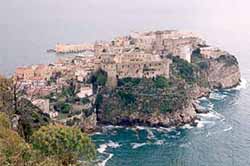 To
avoid bloodshed in the major city of Naples, the king and his army retreated
to Gaeta (photo, left) to make what turned out to be a last stand. In
late 1860 and early 1861, the forces of Victor Emanuel II lay
siege to the stronghold of Gaeta and eventually overcame the defenders.
It was this brief episode that gained Maria Sophia the reputation that
stayed with her for the rest of her life. She was tireless in her efforts
to rally the defenders, giving them her own food, caring for the wounded,
and daring the attackers to come within range of the fortress cannon.
She refused the chivalrous offer from the attacking general that if
she would but mark her residence with a flag, he would make sure not
to fire upon it with artillery. Go ahead and shoot at me, she said;
I will be where the men are. In one lighthearted episode—if anything
at all can relieve the horrors of a four-month siege—she assembled
the men on the seaside rampart, had them turn around, pull down their
trousers and "moon" the attacker fleet. She was worshipped unto idolatry
by her men. To
avoid bloodshed in the major city of Naples, the king and his army retreated
to Gaeta (photo, left) to make what turned out to be a last stand. In
late 1860 and early 1861, the forces of Victor Emanuel II lay
siege to the stronghold of Gaeta and eventually overcame the defenders.
It was this brief episode that gained Maria Sophia the reputation that
stayed with her for the rest of her life. She was tireless in her efforts
to rally the defenders, giving them her own food, caring for the wounded,
and daring the attackers to come within range of the fortress cannon.
She refused the chivalrous offer from the attacking general that if
she would but mark her residence with a flag, he would make sure not
to fire upon it with artillery. Go ahead and shoot at me, she said;
I will be where the men are. In one lighthearted episode—if anything
at all can relieve the horrors of a four-month siege—she assembled
the men on the seaside rampart, had them turn around, pull down their
trousers and "moon" the attacker fleet. She was worshipped unto idolatry
by her men.
King
Francis II, the last King of Naples
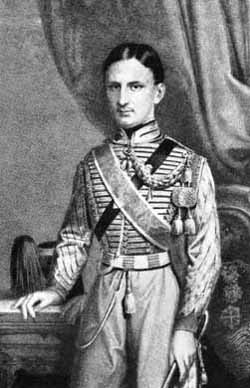 The defense
was in vain. There are many accounts of the Bourbon defense of Gaeta,
written at the time or shortly thereafter. Among the most interesting
is Journal du siège de Gaëte by the Belgian journalist,
Charles Garnier (published in Brussels in 1861). The author was in the
besieged fortress town for the duration, his daily journal entries running
from November 4, 1860 through February 14, 1861. His diary of the siege
is an entirely sympathetic account of heroism in the face of certain
defeat; it is grim in the details of constant bombardment, disease,
and hunger, yet upbeat in the description of the optimism of the defenders,
who were cheerful enough to dress up for carnevale and scurry
about with artillery shells landing nearby. The account skimps on personal
descriptions of King Francis and Queen Maria Sophia, "so as not to place
vain ornaments at the foot of the pedestal for which the Bourbons of
Naples are destined." Yet, the few details are kind, describing how
the Queen placed her own food at the disposal of the wounded, and so
forth. Garnier's last image of the Queen is after the surrender, as
the French ship, Mouette, leaves Gaeta to carry the royal family
into exile: "The queen remained by herself at the prow, leaning on the
railing and contemplating the cliffs of Gaeta." When it was over, the
Bourbon officers and men could choose to go home or even take leave
and then return to be part of the new all–Italian army. The defense
was in vain. There are many accounts of the Bourbon defense of Gaeta,
written at the time or shortly thereafter. Among the most interesting
is Journal du siège de Gaëte by the Belgian journalist,
Charles Garnier (published in Brussels in 1861). The author was in the
besieged fortress town for the duration, his daily journal entries running
from November 4, 1860 through February 14, 1861. His diary of the siege
is an entirely sympathetic account of heroism in the face of certain
defeat; it is grim in the details of constant bombardment, disease,
and hunger, yet upbeat in the description of the optimism of the defenders,
who were cheerful enough to dress up for carnevale and scurry
about with artillery shells landing nearby. The account skimps on personal
descriptions of King Francis and Queen Maria Sophia, "so as not to place
vain ornaments at the foot of the pedestal for which the Bourbons of
Naples are destined." Yet, the few details are kind, describing how
the Queen placed her own food at the disposal of the wounded, and so
forth. Garnier's last image of the Queen is after the surrender, as
the French ship, Mouette, leaves Gaeta to carry the royal family
into exile: "The queen remained by herself at the prow, leaning on the
railing and contemplating the cliffs of Gaeta." When it was over, the
Bourbon officers and men could choose to go home or even take leave
and then return to be part of the new all–Italian army.
Interestingly,
the defense of Gaeta was not the last gasp of the Bourbons, militarily
speaking. That honor goes to the fortress of Messina in Sicily and,
in the northernmost part of the kingdom, the hill-top fortress of Civitella
di Tronto near the Adriatic. They surrendered on March 15 and March
20, respectively, over a month after the King and Queen of Naples had
left Gaeta.
Maria Sophia
and her husband went into exile in Rome, the capital of what for 1,000
years had been the sizeable Vatican States--a large chunk of central
Italy. By 1860, however, the "Patrimony of Saint Peter," as it was also
called, had been reduced to the city of Rome, itself, as the armies
of Victor Emanuel II came down from the north to join up with Garibaldi,
the conqueror of the south.
Throughout
the decade of the 1860s, Rome was a hotbed of what was then called "legitimism"—those
who resisted the waves of revolution that shook Europe in the mid–1800s,
revolution that was eventually responsible for the death of absolutism
and the rise of constitutional government throughout the continent.
Stopping revolution and returning to an older order had happened before
in Europe. After all, Napoleon had been overthrown in 1814 and the subsequent
Congress of Vienna had, indeed, restored "legitimacy," returning kingdoms
and fortunes to their previous owners. Maybe it could happen again—that
thought was no doubt foremost in the minds of the royalist soldiers
and adventurers who made up what amounted to a small "foreign legion"
in Rome and who gathered around the ex–king and queen of Naples.
King Francis set up a government in exile in Rome that enjoyed diplomatic
recogntion by most European states for a few years as still the legitimate
government of the Kingdom of the Two Sicilies. The Bourbons of Naples
even had the sympathy and support of the Pope, himself the absolutist
king of the Papal States, who had considerable support throughout Europe
in his denunciations of the "–isms" of revolution: socialism,
communism, republicanism, and anarchism. Indeed, the Pope's own legitimacy
had been restored in 1849 when the united armies of Catholic Europe
answered his call for help, overthrowing the short-lived Roman Republic
and restoring the Papal State.
The defeat
of the Bourbons of Naples, their subsequent presence in Rome for 10
years, and the soon-to-be outrageously farfetched hopes for yet another
general counter-revolution to restore the "legitimacy" of the old order
in Italy—all this was very much discussed in the press of the
day. An article by William Chauncey Langdon entitled "The Last Stand
of the Italian Bourbons" appeared in The Atlantic Monthly for
November 1884. The author is writing 25 years after King Francis and
Queen Maria Sophia took up residence in Rome after the fall of their
kingdom and only 15 years after the fall of the Papal state, when they
were forced to leave Rome for elsewhere. He comments first on their
defeat at Gaeta, then on "legitimist" sympathies, and then on the presence
of the Neapolitan royal family in Rome during the 1860s:
| …
The week subsequent to the entrance into Naples, Francis II.,
defeated on the Garigliano and at Capua, took refuge, with his
young Bavarian queen and younger brothers and sisters, in Gaeta,
where he was at once besieged by Generals Cialdini and Menabrea.
On this last promontory between the Neapolitan and the Papal States
young Bourbon royalty stood gallantly at bay… "
…
It is strange—or at least it seems so to us now—that
many of the Americans and English at the time resident in Rome
not only were sceptical of the ultimate success of the Italian
revolution, but even sympathized with the old regimes which
were then, one by one, giving way before it. The enthusiastic
new-comer was quietly assured by the better informed old resident
that the apparently rising tide would soon ebb again, as in
1849; and that the inevitable reaction would re-establish more
firmly than before the thrones now placed in seeming jeopardy…
…Pius
IX. welcomed the late royal family with somewhat ostentatious
hospitality…The shadow of a court gathered round them
there…and during the rest of the winter and in the spring
which followed they were not infrequently seen driving in the
Villa Borghese or on the Pincio. The young queen ever won upon
the kindly interest and sympathy of every one who looked upon
her almost girlish figure, her fair face and placid brow, and
who thought what it must be to be the wife of an exiled king
of Naples. Francis sat silent, gloomy, saturnine…
…a
last glance at this hapless pair, thus passing out of history,
is found in the following extract from a journal description
of the ceremonies at St. Peter’s on Thursday of Holy Week…
"At
the lavanda, — that is, the formal pontifical foot-washing,
—I remained long enough to see first the pilgrims come
in…With the queen we were all pleased. She is perhaps
not beautiful, but very bright and interesting, — a face
full of spirit. Near Francis were, apparently, his three brothers,
every one of whom was better looking and had a better expression
than the king. His four or five young sisters also were, all
but one, pleasing-looking girls…”
...These
last Bourbon royalties of Italy remained in Rome for some years,
vainly hoping and attempting to create a favorable occasion
for stirring up a reaction, or at least a conspiracy of one
kind or another, in the late kingdom of the Two Sicilies…At
last, one by one, they left Rome for Austria or for Bavaria.
Bourbon rule in Italy was at an end forever…
|
Even earlier
than the above excerpt, another item from the popular press contains
one person's memories of Maria Sophia. The article was entitled "Royal
Exiles and Imperial Parvenus." It was signed only by "An Englishwoman"
and appeared in an American magazine, The Galaxy, in the issue
for October 1872—just two years after the Papal State fell once
and for all to the forces of Italy, and the ex-King and Queen had moved
elsewhere. Her perceptions [slightly edited, here below] of the last
queen of Naples are, clearly, mixed:
| The
Palazzo Farnese in Rome was, when I knew it in 1863, the refuge
of that modern Joan of Arc, the ex-Queen of Naples… She
seemed to me the most lovely vision I had ever seen. Her dark
hair…reached half way down her back, and seemed ready to
burst the wide-meshed net that confined it. Her eyes and color
added to the sprightly, bewitching beauty of her face, and her
carriage was absolutely the most willowy and graceful I ever saw.…
Physically brave and enduring she certainly was, having been fearlessly
and boyishly brought up, inured to exercise, accustomed to adventure,
and fond of all athletic exercises. But there the dream of Joan
of Arc must end; the high moral resolve, the far-seeing grasp
of mind, were utterly wanting… So fair a shrine, but so
feeble a lamp within! It was a pity to see her thus. She was seldom
in Rome, and only came in occasionally to receive her husband’s
subjects and the “distinguished foreigners” who wished
to be presented to the “heroine of Gaeta.” |
Pope
Pius IX blessing the troops before the last defense of the Papal States.
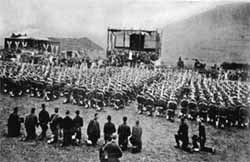 In 1870,
Rome fell to the forces of Italy; the Papal States shrank to a few acres
on the banks of the Tiber, and the King and Queen moved into exile elsewhere.
The king died in 1894. Maria Sophia spent time in Munich, and then moved
to Paris. Her activities were, however, far from over. Maria Sophia,
herself, said that even if she could never get her kingdom back, she
could at least get revenge. In 1870,
Rome fell to the forces of Italy; the Papal States shrank to a few acres
on the banks of the Tiber, and the King and Queen moved into exile elsewhere.
The king died in 1894. Maria Sophia spent time in Munich, and then moved
to Paris. Her activities were, however, far from over. Maria Sophia,
herself, said that even if she could never get her kingdom back, she
could at least get revenge.
Italy in
the mid-1890s was not a stable nation. The north was shaken by domestic
unrest, including one famous episode in 1898 in Milan in which the army
brutally put down what the government feared—or said it feared—was
the beginning of an anarchist revolution to destabilize and then fragment
the state. (That "revolution" was apparently not much more than a bread
riot by the unemployed.) There was, at the time, a large anarchist movement
in Europe, those who remembered the failed Paris Commune of 1871 and
who were ready for another try. That movement centered in Paris, and
many of the anarchists gravitated to the informal court of the ex-queen
of Naples. After all, they both had a similar aim: destabilize Italy.
Frontpage
after the murder of the king
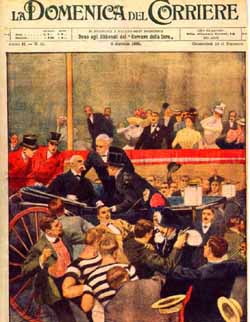 It was
rumored that Maria Sophia was involved in the assassination of King
Humbert in 1900. She knew the anarchists who recruited the assassins.
That is not evidence of anything, of course, but it certainly fed the
rumor mills of united Italy for a few years—the ex-queen helping
to commit murder (!) out of some deranged desire for revenge on those
who had taken her realm. During World War I, she was actively on the
side of Germany and Austria in their war with Italy. Again, the rumors
claimed she was involved in sabotage and espionage against Italy in
the hope that an Italian defeat would tear the nation apart and that
the kingdom of Naples would be restored. It was
rumored that Maria Sophia was involved in the assassination of King
Humbert in 1900. She knew the anarchists who recruited the assassins.
That is not evidence of anything, of course, but it certainly fed the
rumor mills of united Italy for a few years—the ex-queen helping
to commit murder (!) out of some deranged desire for revenge on those
who had taken her realm. During World War I, she was actively on the
side of Germany and Austria in their war with Italy. Again, the rumors
claimed she was involved in sabotage and espionage against Italy in
the hope that an Italian defeat would tear the nation apart and that
the kingdom of Naples would be restored.
All of
that was rendered moot by the great political and social changes in
Europe between the time of her role as a "modern Joan of Arc" in 1860
and her death in 1925: Her own Kingdom of Bavaria was taken up into
a united German Empire; Italy became, irrevocably, a single nation state;
some four million Italians (most of them from the south, the ex-kingdom
of the Two Sicilies) emigrated to America between 1880 and 1920
(the possible relationship between the unity of the nation and massive
emigration is fascinating, but a topic for another time); and European
nations were devastated by the Great War. She lived to see Mussolini
take power in Italy and to see Hitler make his first move in Germany.
(Maria Sophia was still active enough in her 80s to stand at the window
of her apartment in Munich and look at anarchists and police battling
in the streets. She wanted "to see if young people of today still have
the stuff they had when I was young.”)
The wealth
and privilege in Maria Sophia's life were, to a certain extent, overshadowed
by personal tragedies. Her only child by her husband died in infancy.
Also, thanks to Armand de Lawayss, a Belgian count and officer in the
foreign forces holed up in Rome, she had twins in 1862. Both of them
survived and both were taken from her by her all-wise, scandal-conscious
royal Bavarian relatives. It is not clear that she ever saw them again,
except once or twice, briefly and under supervision. In the late 1890s,
her younger sister, Charlotte, died heroically while trying to help
others from a burning building. Shortly thereafter, in 1898, her older
sister, Elizabeth, the wife of Franz Josef, the last Austrian emperor,
was stabbed to death by an anarchist.
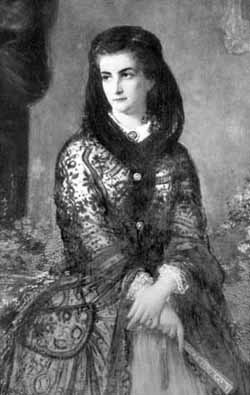 Maria
Sophia died in Munich in 1925. The January 20, 1925 edition of il
Mattino, the largest newspaper in Naples, the ex-capital of her
ex-kingdom—65 years (!) after she had ceased to be relevant to
the affairs of southern Italy—still saw fit to devote two full
columns to her on the front page beneath the banner headline, "Maria
Sofia, ex-queen of Naples, is dead." The write-up was almost totally
positive, dwelling on the queen's personal courage, anti-traditionalism,
and generosity. It pointed out how she visited and consoled Italian
prisoners of war interned in Germany during WW I, and how she made sure—to
the very end of her life when she, herself, was not well-off, financially—to
maintain pension payments to the last of her personal servants, a man
who had served her in Gaeta 65 years earlier. The paper made no mention
of any supposed connection between her and Italian anarchists nor supposed
involvement in a plot to assassinate King Humbert in 1900. The article,
in a single negative note, said that Maria Sophia had been responsible
for "organizing banditry in the 1860s in the south." (The term "banditry,"
as used in that context, may be read as code for "armed resistance by
Bourbon troops and sympathisers who refused to surrender to the forces
of the new Italy.") Other than that, the paper praised her with "She
was one of those European princesses who, with her great gifts, would
have had another destiny but for the dramatic events of her times." Maria
Sophia died in Munich in 1925. The January 20, 1925 edition of il
Mattino, the largest newspaper in Naples, the ex-capital of her
ex-kingdom—65 years (!) after she had ceased to be relevant to
the affairs of southern Italy—still saw fit to devote two full
columns to her on the front page beneath the banner headline, "Maria
Sofia, ex-queen of Naples, is dead." The write-up was almost totally
positive, dwelling on the queen's personal courage, anti-traditionalism,
and generosity. It pointed out how she visited and consoled Italian
prisoners of war interned in Germany during WW I, and how she made sure—to
the very end of her life when she, herself, was not well-off, financially—to
maintain pension payments to the last of her personal servants, a man
who had served her in Gaeta 65 years earlier. The paper made no mention
of any supposed connection between her and Italian anarchists nor supposed
involvement in a plot to assassinate King Humbert in 1900. The article,
in a single negative note, said that Maria Sophia had been responsible
for "organizing banditry in the 1860s in the south." (The term "banditry,"
as used in that context, may be read as code for "armed resistance by
Bourbon troops and sympathisers who refused to surrender to the forces
of the new Italy.") Other than that, the paper praised her with "She
was one of those European princesses who, with her great gifts, would
have had another destiny but for the dramatic events of her times."
She, her
husband, and their only child found their last resting place in 1984
when their remains were brought to Naples and interred in the Church
of Santa Chiara.
There
is a considerable bibliography on the last days of the Bourbons of Naples,
but I am not aware of an original English-language biography of Maria
Sophia. Some Italian biographies are:
Una
Regina contro il Risorgimento. F.Castiglione. Pietro Lacaita Editore.
Roma. 1999.
Maria
Sofia, ultima regina di Napoli, A. Tosti. Milano. 1947;
Maria
Sofia; l'eroina di Gaeta. A. Mangone. Grimaldi. Napoli. 1992;
Regina
del Sud, A. Petacco. Mondadori (Milano). 1992.
One
interesting book—because it was written in 1905, while Maria Sophia
was still alive—is Maria Sophia, Queen of Naples: A Continuation
of "The Empress Elizabeth" by Clara Tschudi. The original is in
Norwegian. An English translation by Edith Harriet Hearn exists. It
is a sympathetic portrayal of Maria Sofia and leaves off right after
the personal tragedies involving her sisters.
Paisiello,
Giovanni
(1740-1816)
 If
remembered at all today by the average concert-goer, Paisiello is the
one who wrote "the other Barber of Seville" (in 1782 --which
might make Rossini's Barbiere from
1816 the "other" one. But history knows best, I suppose.) Paisiello
was born in Taranto and attended the S. Onofrio music
conservatory in Naples from 1754 to 1763. He composed opera for
northern Italian theaters at first and then returned to Naples in 1766
where he wrote both comic opera and opera
seria for the various music theaters, including San Carlo. If
remembered at all today by the average concert-goer, Paisiello is the
one who wrote "the other Barber of Seville" (in 1782 --which
might make Rossini's Barbiere from
1816 the "other" one. But history knows best, I suppose.) Paisiello
was born in Taranto and attended the S. Onofrio music
conservatory in Naples from 1754 to 1763. He composed opera for
northern Italian theaters at first and then returned to Naples in 1766
where he wrote both comic opera and opera
seria for the various music theaters, including San Carlo.
In 1776
he accepted an invitation from Catherine II of Russia to be her maestro
di cappella, becoming one of a number of Italian composers in the
late 18th century to move north and take on the daunting challenge of
teaching the tone-deaf czarina something about music. (Another Neapolitan
to do so was Domenico Cimarosa.) It was
in St. Petersburg that Paisiello composed The Barber of Seville,
a comic opera based on one book of a trilogy by Beaumarchais (pen name
of Pierre Augustin Caron, 1732-99). (Mozart's opera on the other comic
masterpiece from the same trilogy, The Marriage of Figaro, is
from 1786.) Interestingly, modern Russian musicians are likely to think
of Paisiello rather than Rossini if you mention The Barber of Seville;
Russian companies still perform it and even travel abroad with it. One
such company from Moscow performed it to splendid reviews in Naples
in the late 1980s.
Paisiello
was clearly not happy in Russia and returned to Naples where he became
the favorite composer of King Ferdinand
as well as the official court composer. His Barbiere was performed
in Naples in 1783 and developed into a mainstay of the Neapolitan comic
opera form. He received a regular salary in return for composing music
as needed by the court. He then suffered some sort of a mental breakdown
and his output slowed considerably. Henceforth he devoted much of his
artistic energies to religious music, and in 1796 he was appointed maestro
di cappella of the Naples Cathedral. By that time, it is fair to
say that he was one of the best-known Italian composers of his day,
an honor perhaps shared with his Neapolitan contemporary, Cimarosa.
The political
events of the 1790s touched Paisiello just as they did Cimarosa. Paisiello,
the King's favorite, did not flee from Naples to Sicily with the royal
family when revolutionary forces, supported by the French army, proclaimed
the Neapolitan Republic in early 1799. He stayed behind and, like Cimarosa,
composed music for the Republic. When the Republic fell, Paisiello's
role was scrutinized and he was pardoned. He left for Paris at the request
of Napoleon who commissioned various works from him, including music
used in Napoleon's coronation as emperor in 1804.
When the
French army then invaded Naples and sent the royal family packing once
again to Sicily, Paisiello again stayed on, first as composer to the
court of the new king, Napoleon's brother, Joseph, and then Joseph's
replacement, Joachim Murat. He was undoubtedly
the privileged musician in the Naples of his day, enjoying the favor
of the monarch as well as, from afar, that of the emperor, himself.
At Bonaparte's ultimate departure from the scene in 1815, King Ferdinand,
again on the throne of Naples, granted an amnesty to former supporters
of the French. This included Paisiello, who died in June of 1816.
At least
once fictional representation of the life of Rossini, an Italian film
from the 1930s, puts Paisiello at the first performance of Rossini's
Barber of Seville. The performance was a disaster due to roughneck
Neapolitan hecklers who did not like the idea of the young northerner,
Rossini, reworking one of their favorite Neapolitan comic operas. In
the film, Paisiello apologizes to Rossini for the behavior the public.
There is no real historic evidence that the episode ever took place,
but it's a good story.
San
Paolo Maggiore
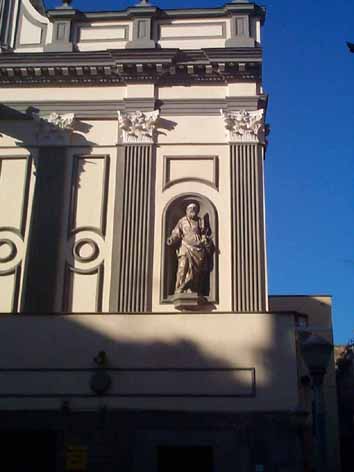 The Church of San Paolo Maggiore is on via dei Tribunali,
one of the three original east-west thoroughfares of the Greek
city of Neapolis. As such, it is a simultaneous
lesson in the history of Naples, the history of Neapolitan architecture
and the history of at least a bit of religion. The church stands above
a spectacular stairway, and, in the form you see today, was built
at the end of the sixteenth century. However, it was erected on the
ruins of a preexisting eighth-century church built to celebrate a Neapolitan
sea victory over Saracen invaders. [For a separate item on early Christian
churches in Naples, click here]. That church, in turn, was built on the
site of —and even incorporated part of the structure of—
a Greek Temple dedicated to Castor and Pollux. There are still two columns
of this temple left intact within the present-day church, anachronistically
connected to a late 16th century facade. It is precisely this out-of-time
aspect which is so characteristic of Neapolitan architecture. There
is fascinating and undeniable confusion, especially in the
original center of the city; perhaps this is an unavoidable phenomenon
when 2,500 years of architecture have to coexist. The Church of San Paolo Maggiore is on via dei Tribunali,
one of the three original east-west thoroughfares of the Greek
city of Neapolis. As such, it is a simultaneous
lesson in the history of Naples, the history of Neapolitan architecture
and the history of at least a bit of religion. The church stands above
a spectacular stairway, and, in the form you see today, was built
at the end of the sixteenth century. However, it was erected on the
ruins of a preexisting eighth-century church built to celebrate a Neapolitan
sea victory over Saracen invaders. [For a separate item on early Christian
churches in Naples, click here]. That church, in turn, was built on the
site of —and even incorporated part of the structure of—
a Greek Temple dedicated to Castor and Pollux. There are still two columns
of this temple left intact within the present-day church, anachronistically
connected to a late 16th century facade. It is precisely this out-of-time
aspect which is so characteristic of Neapolitan architecture. There
is fascinating and undeniable confusion, especially in the
original center of the city; perhaps this is an unavoidable phenomenon
when 2,500 years of architecture have to coexist.
The most
important work of art within the church is the sacresty with the
fresco done in 1690 by the great Neapolitan painter of the Baroque,
Francesco Solimena. Other works, such as the fresco of The Dedication
of the Temple of Solomon are more recent in the history of the church,
dating back to the first years of Bourbon
rule in the 1730s.
Conservatory,
music (2)
 I
don't know when scientific soundproofing came of age—all those
foam baffles, ceiling tiles, fabric panels, and clouds. (I have even
had sound engineers tell me how effective and cheap it is to use good,
old-fashioned cardboard egg cartons.) But I have had the misfortune
of practicing music in large, old rooms—cavernous spaces that
used to resound only to the shuffling sandals of monks—in institutions
that are more willing to spend money on modern electronics than on a
few square yards of anything at all to put on the walls, ceilings and
floors to dampen sound. The echo in such places is a disaster, doubly
so if there are two of you trying to practice. (For more than two, the
disaster becomes logarithmic, and the scale becomes Richter, not B-flat,
measuring major and minor soundquakes of cacophony.) I
don't know when scientific soundproofing came of age—all those
foam baffles, ceiling tiles, fabric panels, and clouds. (I have even
had sound engineers tell me how effective and cheap it is to use good,
old-fashioned cardboard egg cartons.) But I have had the misfortune
of practicing music in large, old rooms—cavernous spaces that
used to resound only to the shuffling sandals of monks—in institutions
that are more willing to spend money on modern electronics than on a
few square yards of anything at all to put on the walls, ceilings and
floors to dampen sound. The echo in such places is a disaster, doubly
so if there are two of you trying to practice. (For more than two, the
disaster becomes logarithmic, and the scale becomes Richter, not B-flat,
measuring major and minor soundquakes of cacophony.)
When you
walk by the music conservatory in Naples,
you hear the sounds of instruments wafting out over the street from
practice rooms on the premises, a monastery that was converted into
a music school in the early 1800s. I have not been inside the building
to see students practicing, so I don't know what they have to put up
with. I hope it is better than this description by Charles Burney (1726-1814)
an English musical historian. He wrote an important 4-volume History
of Music as well as accounts of his travels. I found the following
in Musical Italy Revisited by Sigmund Levarie (MacMillan. New
York. 1963.) The author cites as his source, Charles Burney: Musical
Tours in Europe (ed. Percey A. Scholes. 2 vols. London: Oxford
University Press, 1959). The original source is apparently Burney's
(photo, above) The Present State of Music in France and Italy,
published in 1771. The reference is to the Conservatory of St. Onofrio,
one of the original music schools in Naples before they were combined
into one facility. It was on the premises—as they all were, at
the time—of a monastery.
Burney’s
description, dated Wednesday, 31 October 1770:
| This
morning I went with young Oliver to his Conservatorio of St. Onofrio,
and visited all the rooms where the boys practise, sleep, and
eat. On the first flight of stairs was a trumpeter, screaming
upon his instrument till he was ready to burst; on the second
was a french-horn, bellowing in the same manner. In the common
practising room there was a Dutch concert, consisting of seven
or eight harpsichords, more than as many violins, and several
voices, all performing different things, and in different keys:
other boys were writing in the same room; but it being holiday
time, many were absent who usually study and practise there together.
The
jumbling them all together in this manner may be convenient
for the house, and may teach the boys to attend to their own
parts with firmness, whatever else may be going forward at the
same time; it may likewise give them force, by obliging them
to play loud in order to hear themselves; but in the midst of
such jargon, and continued dissonance, it is wholly impossible
to give any kind of polish or finishing to their performance;
hence the slovenly coarseness so remarkable in their public
exhibitions; and the total want of taste, neatness, and expression
in all these young musicians, till they have acquired them elsewhere.
The
beds, which are in the same room, serve as seats for the harpsichords
and other instruments. Out of thirty or forty boys who were
practising, I could discover but two that were playing the same
piece: some of those who were practising on the violin seemed
to have a great deal of hand. The violon-cellos practise in
another room: and the flutes, hautbois, and other wind instruments,
in a third, except the trumpets and horns, which are obliged
to fag, either on the stairs, or on the top of the house.
There
are in this college sixteen young castrati, and these live up
stairs, by themselves, in warmer apartments than the other boys,
for fear of colds, which might not only render their delicate
voices unfit for exercise at present, but hazard the entire
loss of them for ever.
The
only vacation in these schools, in the whole year, is in autumn,
and that for a few days only: during the winter, the boys rise
two hours before it is light, from which time they continue
their exercise, an hour and a half at dinner excepted, till
eight o’clock at night; and this constant perseverance,
for a number of years, with good teaching, must produce great
musicians.
|
Trianon
Theater
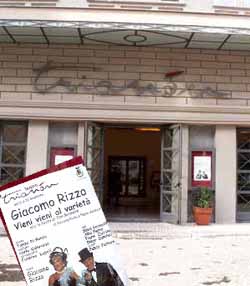 I
am pleased to see that there is once again a theater devoted full-time
to Neapolitan Music. The Trianon Theater takes its name from a village
acquired in 1670 by Louis XIV and converted into a sort of pleasure
garden annexed to the Palace of Versailles. The premises hosted an English
Garden, a theater, fountains, and all those things necessary in the
lives of Madame Pompadour and Marie Antoinette. I
am pleased to see that there is once again a theater devoted full-time
to Neapolitan Music. The Trianon Theater takes its name from a village
acquired in 1670 by Louis XIV and converted into a sort of pleasure
garden annexed to the Palace of Versailles. The premises hosted an English
Garden, a theater, fountains, and all those things necessary in the
lives of Madame Pompadour and Marie Antoinette.
The Trianon
in Naples was less ambitious. It opened in 1911 for the express purpose
of being a theater for local talent. Over the next few decades, it served
Neapolitan playwrights, actors and musicians well. It thrived during
the great age of vaudeville and then survived for a while as motion
pictures swiftly took over show business. Like many theaters of its
kind throughout the world, it finally closed and was converted into
a cinema in 1947.
The Trianon
has now reopened over half a century later as a theater of Neapolitan
Song. It has an impressive program of traditional Neapolitan plays
and musicals, an art gallery, very good acoustics, and, soon, a permanent
multimedia exhibit dedicated to Enrico Caruso. Much of the restructuring of the
Trianon was supervised by musicologist, Roberto
De Simone. The theater is located, appropriately, in a traditional
part of town, Piazza Calenda, at the extreme eastern edge of the old
historic center of Naples. That fact is attested to by the presence
in the square of an excavated portion of the ancient Greek eastern wall
of the city. In modern terms, it is only a block away from Piazza Garibaldi
and the main train station.
Annunziata,
Church 2
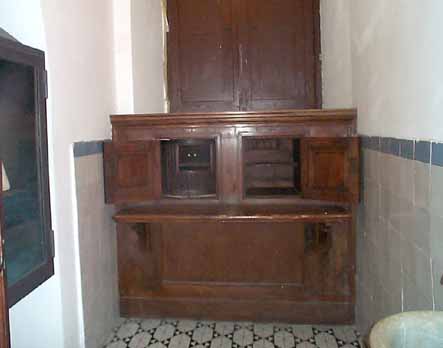 In the first entry for
this church, I refer to the Church of the Annunziata and a "revolving
Ferris-wheel-type affair with basket-cribs in place around the perimeter
that each held a child"—well, that was wrong. Close, but wrong. In the first entry for
this church, I refer to the Church of the Annunziata and a "revolving
Ferris-wheel-type affair with basket-cribs in place around the perimeter
that each held a child"—well, that was wrong. Close, but wrong.
I went
to the Church of the Annunziata this morning and was happy to note that
it is now the site of a quasi-permanent historical display sponsored
by the cultural powers-that-be in the city government. As well, the
church and premises have been "adopted" by enthusiastic and diligent
pupils of two local elementary school. (This is not uncommon in Naples.
The Church of the Incoronata is another such example.)
The children have filled the entrance to the Annunziata with large displays
boards of snapshots, drawings, poetry, handwritten stories of the church,
explanations of the traditions surrounding the long history of the church,
papier maché models of the façade, and even one
almost life-sized cardboard replica of the item I misdescribed earlier,
called la ruota—the wheel.
The "wheel"
(photo) in question is actually a revolving single-basket contraption—somewhat
like a "lazy Susan"—contained within a wooden frame about the
size of a large chest of drawers. It was embedded in the wall of the
front of the church with one side open to the street and the other within
the church, like an automatic teller machine (to make an utterly inappropriate
comparison!) Women who wanted to leave a child could open, from the
street side, the compartment with the revolving basket, then put the
infant inside and turn the device so that the basket moved around to
the inside of the church where a nun was waiting. The current display
in the room inside the church shows the "wheel," a small wash basin
where the new arrivals were bathed, and a register—a book open
to pages from the 1600s, the entries of which note the arrival and the
sex and general physical condition of the infant. This unusual set-up
guaranteed the anonymity of the woman since there was a wall between
her and whoever accepted the infant on the other side. It was also,
presumably, a kinder way to abandon a newborn child—that is, directly
into the hands of someone who would care for it.
Comic
books; De Filippo, Eduardo (3)
artwork:
Mauro Salvatori &Fabrizio Faina
lettering: Luca Lermano ©ELLEDI'91
 I remember sitting in the Tokyo subway one time next
to a young gentleman who was elegantly power-dressed —probably
on his way to a Toshiba board of directors meeting. He was reading a
comic book, the title of which was —I was able to piece this together
from my meagre knowledge of Japanese and by asking him not to turn the
pages so fast— Mutant Sex Slaves from Beyond Infinity. I remember sitting in the Tokyo subway one time next
to a young gentleman who was elegantly power-dressed —probably
on his way to a Toshiba board of directors meeting. He was reading a
comic book, the title of which was —I was able to piece this together
from my meagre knowledge of Japanese and by asking him not to turn the
pages so fast— Mutant Sex Slaves from Beyond Infinity.
Maybe an
adult reading a comic book shouldn't have surprised me, nor are his
tastes any of my concern. A lot of people like comics, and I am aware
of their cultural importance because they say something profound about
this or that. My own Jr. High School book reports would have been impossible
but for the existence of the famous (or infamous) Classics Illustrated,
a comic book series started in 1947 by a Russian immigrant Albert Kanter.
Number 1 in the series was The Three Musketeers. (That issue,
in very fine condition, costs $225 on the internet these days. I paid
10 cents back then. Is there a message in there, somewhere?) I recall
collecting most of the Classics Illustrated up to about number
100, Mutiny on the Bounty, when my tastes changed more in the
direction of soft, living non-collectibles who made you buy them stuff.
English
teachers hated those comics. We loved them, and how fondly I recall
the epistemological debates that swirled around whether —in lieu
of actually reading the book—one should use these comics—which
I favored—or a book called 100 Famous Plot Outlines —favored
by my best friend, Steve. He is still my best friend, and we have not
resolved that dispute to this day.
Comics
abound in Italian culture, and if there is a local, Neapolitan attempt
to bring famous literary figures to life sporting little balloons above
or beside their heads, it is probably a series dedicated to (from the
cover) "the most significant works of the great Eduardo De Filippo,"
(published monthly in 1998 by Elledi'91 s.r.l. in Scafati, near Salerno).
There were 12 issues in all, covering, indeed, much of the important
literary output of Naples' most famous playwright of the 20th century
(see, also, this entry).
I happen
to be looking at the issue dedicated to the play, Filumena Marturano,
but the format is identical on all of them: 30 x 21 cm (about the size
of a standard sheet of typewriting paper), glossy color cover, about
60 black-and-white pages with 6 to 8 cartoon panels to a page. Credit
is given in the editorial information to those who adapted the text
of the original play, the cartoonists, and those who did the lettering.
Additionally, there are some paragraphs of praise from a few people
in the De Filippo family who like the idea.
Eduardo,
himself, was acknowledged to be the best interpreter of the roles that
he created for himself in his plays. Thus, in a sense, he still "owns"
those roles, and the male lead in all of these comic versions of his
plays is rendered as Eduardo (see illustration, above). Also important
if you are not Neapolitan is the fact that the comics all contain some
sort of Neapolitan/Italian glossary to help decipher the authentic,
densely Neapolitan dialect of the text. Each issue includes, as well,
a short written introduction to the work, of the kind that you might
find in an encyclopedia of literature.
At the
time, the series claimed to be part of an effort to present great world
literature in comic format, but I have not seen any others. Maybe they
stopped at number 1.
Cuma
(2), oracles
Deep
in a cave the Sibyl makes abode;
Thence full of fate returns, and of the god.
Thro' Trivia's grove they walk; and now behold,
And enter now, the temple roof'd with gold.
The
Aeneid book 6, 10-13,
trans. John Dryden
The
cave of the sibyl of Cuma
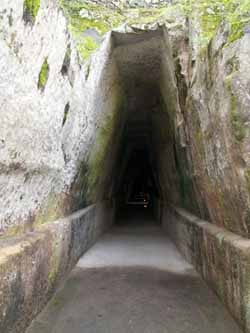 "Oracle"
meant three things in ancient Greece; (1) the person through whom a
god speaks; (2) the temple or shrine assocated with this process; and
(3) the actual answer or phrophecy given by a god through the prophet,
usually a priestess. There were many such sites in Greece and Magna
Grecia. The most famous of these was certainly the site at Deplhi, on
the slopes of Mt. Parnassus, a site protected by Apollo, himself. The
term "delphic" has, of course, come to mean, by extension, "obscure"
or "cryptic". The temples were generally on some sacred site, a place
thought to be specially endowed with qualities that would enhance the
oracular abilities of the priestess—perhaps a spring, a cave,
a mountain peak, or a place often struck by lightning. Strabo (A.D.
46-120) spoke of the pneuma, the gas or vapour that arose from
a cleft in the earth. It was inhaled by the priestess, thus inducing
the trance in which she could intrepret the answers from the gods correctly. "Oracle"
meant three things in ancient Greece; (1) the person through whom a
god speaks; (2) the temple or shrine assocated with this process; and
(3) the actual answer or phrophecy given by a god through the prophet,
usually a priestess. There were many such sites in Greece and Magna
Grecia. The most famous of these was certainly the site at Deplhi, on
the slopes of Mt. Parnassus, a site protected by Apollo, himself. The
term "delphic" has, of course, come to mean, by extension, "obscure"
or "cryptic". The temples were generally on some sacred site, a place
thought to be specially endowed with qualities that would enhance the
oracular abilities of the priestess—perhaps a spring, a cave,
a mountain peak, or a place often struck by lightning. Strabo (A.D.
46-120) spoke of the pneuma, the gas or vapour that arose from
a cleft in the earth. It was inhaled by the priestess, thus inducing
the trance in which she could intrepret the answers from the gods correctly.
In 1900,
a scholar, Adolpe Paul Oppé, wrote that no such chasm or cleft
existed at Delphi, and that, anyway, no gas could imitate the symptoms
of spiritual possession. Since that time, modern science has sort of
pooh-poohed the idea of pneuma-induced trances at Delphi, and,
by extension, other such sites in the world of ancient Greece. Now,
lo and behold, according to the August 2003 issue of Scientific American,
"two geologic faults that intersect precisely under the site of the
oracle [have been found]..." and "...the petrochemical-rich layers in
the limestone formations of the region most likely produced ethylene,
a gas that induces a trancelike state and that could have risen through
fissures created by the faults."
After inhaling
a goodly quantity of ethylene, I am reminded of our local oracle, Cuma,
the sibyl of which handed out propecies just like her sisters in Greece.
As far as I'm concerned, the sibyl of Cuma was even better; after all,
her name has generalized to "sibylline," meaning "mysterious," obviously
better than "delphic"— "obscure". I would rather be sibylline
than delphic, any day, and I'm sure I speak for most ethylene breathers.
Geologically,
I wonder if investigators of Delphi might like to come and have a look
at Cuma, on the edge of the infamous "Phlegrean Fields," one of the
most geologically active zones in Europe. We have clefts and bubbling
sulphur pits and caves with abundant pneuma. Of one such place,
Mark Twain wrote:
| ...but
the Grotto of the Dog [at Lake Averno] claimed our chief attention,
because we had heard and read so much about it. Everybody has
written about the Grotto del Cane and its poisonous vapors,
from Pliny down to Smith, and every tourist has held a dog over
its floor by the legs to test the capabilities of the place. The
dog dies in a minute and a half --a chicken instantly. As a general
thing, strangers who crawl in there to sleep do not get up until
they are called. And then they don’t, either. The stranger
that ventures to sleep there takes a permanent contract. I longed
to see this grotto. I resolved to take a dog and hold him myself;
suffocate him a little, and time him; suffocate him some more,
and then finish him. We reached the grotto about three in the
afternoon, and proceeded at once to make the experiments. But
now, an important difficulty presented itself. We had no dog... |
Dangling
a beautiful priestess over a pit of pneuma? Now, that's my idea
of a good time.
Bellini,
Vincenzo (1801-35)
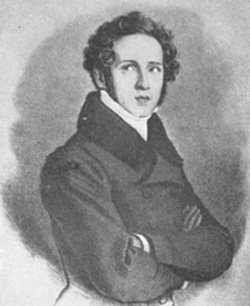 A
small, delightful square near the Naples
Music Conservatory is named for this early giant of Italian Romanticism
and attests to his importance in the cultural life of the city. Bellini
was from Sicily and was born into a musical family, his father having
studied at the Conservatory in Naples.
There is abundant lore about Bellini's early display of musical ability,
including conducting at aged three, playing the piano expertly at five,
and composing at six. A
small, delightful square near the Naples
Music Conservatory is named for this early giant of Italian Romanticism
and attests to his importance in the cultural life of the city. Bellini
was from Sicily and was born into a musical family, his father having
studied at the Conservatory in Naples.
There is abundant lore about Bellini's early display of musical ability,
including conducting at aged three, playing the piano expertly at five,
and composing at six.
In 1819 he was granted a scholarship to study at the Royal Conservatory
in Naples, a recent consolidation (under Murat's
reign in Naples) of four separate church-run music schools.
The atmosphere of the conservatory was somewhat conservative, more in
keeping with the line of recent, prominent Neapolitan composers such
as Paisiello and Cimarosa,
rather than with the more dynamic style of Rossini,
who was the resident composer for Neapolitan music theaters from 1815-22.
Nevertheless, it would be impossible to expect Rossini to have had no
influence on young composers of the day; if Bellini is at the forefront
of early Italian Romanticism, at least part of his creativity can be
seen as a constant reaction to the music of Rossini.
After graduation
from the conservatory, Bellini's first commercial effort was in 1826
with Bianca e Ferdinando, retitled Bianca e Gernando to
avoid allusion to the recently deceased Ferdinand I of Naples. (Such
piddling, political interference in culture was becoming more and more
typical in the Kingdom of Naples of the time and is one of the reasons
that Verdi, later, complained that Naples had become an absolutist backwater.)
There is, even in early Rossini, a trend to the unadorned, simple melody
that is the hallmark of Italian lyric Romanticism — melodies that
attracted the adjective "philosophical" to describe them by critics
of the day. Upon closer analysis, such melodies seem natural in opera
because they use lyrics well, making them conform to the natural cadences
of speech. (Verdi once referred to "Bellini's long, long, long melodies."
He meant it as a compliment.)
Bellini
left Naples in 1827 to live and work in Milan at La Scala. Much of what
we know of his life comes from a biography and an edition of his letters,
both by Francesco Florimo, a classmate in Naples and a lifelong friend.
(Florimo lived until 1888, through both musical and political revolutions,
long enough to hear Verdi and Wagner at the height of their powers and
long enough to see his native Kingdom of Naples absorbed into greater
Italy.)
Bellini's
important musical contributions come in the period after leaving Naples.
These include: Il pirata (1827); La straniera (1829);
La sonnambula (1831); Norma (1831); I puritani (1835).
They were all successful and established Bellini as one of those unusual
composers who was able to live just from writing opera.
Bellini
lived the last years of his life in the company of his mistress, Guidetta
Turnia of Genova. She was young, rich, and married. Their exact relationship
is unclear since Bellini's biographer, Florimo, chose to destroy the
relevant correspondence. Bellini died in Paris at the age of 34.
Padula,
certosa
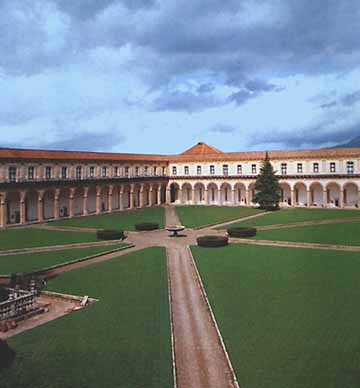 A workshop is currently running at the San Lorenzo monastery
in Padula, east of Salerno. It is dedicated to the art of landscaping
and gardening. The organizers picked a good place for the workshop.
The monastery is on the edge of the Cilento and Vallo di Diano national
park, one of the most bucolic settings in Italy, and the monastery grounds,
themselves—as most such places—have a long history of cultivating
nature as well as the spirit. In the case of San Lorenzo, that history
has had its ups and downs. A workshop is currently running at the San Lorenzo monastery
in Padula, east of Salerno. It is dedicated to the art of landscaping
and gardening. The organizers picked a good place for the workshop.
The monastery is on the edge of the Cilento and Vallo di Diano national
park, one of the most bucolic settings in Italy, and the monastery grounds,
themselves—as most such places—have a long history of cultivating
nature as well as the spirit. In the case of San Lorenzo, that history
has had its ups and downs.
The monastery
was founded in 1306 on an earlier site belonging to the Abbey of Montevergine.
Technically, it is called in Italian the "Certosa" (not "Monastery")
of Padula because it was built for the Certosines, a French monastic
order, one favored by the French Angevin rulers of Naples. The order
then took on the responsibility of reclaiming the area from swampy conditions
into which it had degraded since the fall of the Roman Empire, 800 years
earlier. Even today—just off the main north-south A3 autostrada—
the area is in the middle of nowhere. Imagine 1300. The area, presumably,
was of some strategic importance during the days of Magna Grecia since
it is relatively near the ancient Greek port of Velia; then it was important
to the subsequent rulers of Rome, who used the nearby Tanagro river
for navigation. Thus, major land reclamation was undertaken by both
the Certosine and Benedictine orders at the end of the 13th and beginning
of the 14th century.
The complex
has been relatively ignored in the recent history of southern
Italy, all the more interesting since it was—and is—so vast.
Throughout the centuries, well into the 1700s when the architects of
the by-then Bourbon Kingdom of Naples added their ornamental touches,
the certosa was modified and added to, all in the sense of keeping
it a truly self-sufficient community, thriving on its own agriculture
and crafts.
When the
French took over the Kingdom of Naples, the fate of the certosa
was the same as that of all monasteries in Napoleonic Europe—it
was closed. The order was dispossessed and the treasures within—not
just gold and silver religious trinkets, but treasures of culture, the
books in the library (the great monastic library, the single great preserver
of learning in our Dark Ages) were scattered. Those items from the certosa—those
that remain— currently reside in various institutions in the south
of Italy, including the National Library of Naples. Though the property
was restored to the order after the Congress of Vienna, it was described
in 1845 as a place of "total abandon". The further suppression of monastic
orders and expropriation of church property in the new united nation
of Italy in 1866 ended the 500 year history of the Certosa of
Padula as a working monastery.
In 1882,
many of these institutions, including Padula, were declared national
monuments, which didn't really help; when someone needed the space,
the certosa was used as a hospital, an orphanage, a warehouse,
and a POW camp in both World Wars. In the 1982 the site was put under
the auspices of the Superintendent of Culture of Salerno, at which point
restoration was undertaken, a project that has largely been completed.
Garibaldi
(U.S. reaction) (2)
Garibaldi,
cover of Harper's Weekly.
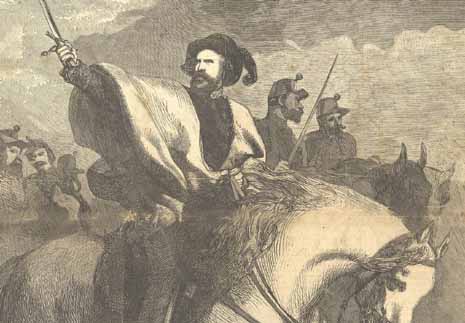 I have come into possession of a fascinating bit of
historical memorabilia: an original copy of Harper's Weekly from
June 9, 1860. There is a short story by Wilkie Collins, a note on the
passing of Lady Byron, some news from Ireland and Mexico, an ad for
Sweet's Infallible Liniment, and one of those 19th century cartoons
that I never understand. But the body of the journal is given over to
the "coming war in Italy". By the time this issue of Harper's went to
press, that war was in full swing, for Garibaldi had landed in Sicily
on May 11 to begin the conquest of the Kingdom of Naples. I have come into possession of a fascinating bit of
historical memorabilia: an original copy of Harper's Weekly from
June 9, 1860. There is a short story by Wilkie Collins, a note on the
passing of Lady Byron, some news from Ireland and Mexico, an ad for
Sweet's Infallible Liniment, and one of those 19th century cartoons
that I never understand. But the body of the journal is given over to
the "coming war in Italy". By the time this issue of Harper's went to
press, that war was in full swing, for Garibaldi had landed in Sicily
on May 11 to begin the conquest of the Kingdom of Naples.
The journal
is in large tabloid format, 8 large sheets folded into 16 pages of newsprint.
The front cover displays a woodcut of "General Giuseppe Garibaldi [from
a recent picture]" posed heroically astride a horse. On the inside pages,
there are other illustrations of the bay of Naples, Messina, and a map
of The Kingdom of the Two Sicilies. By rough count, the journal
has at least 7,000 words of text (in excruciatingly small type!) about
the beginning of the military campaign that eventually united Italy.
All of it is unabashedly pro-unification, pro-Garibaldi, and anti-Bourbon.
That would be in keeping with Howard Marraro's observations (see
here) in his American Opinion on the Unification of Italy, 1846
–61, about the US press, in general, at the time.
Besides
a glowing biographic sketch of Garibaldi, there is an editorial that
"makes no apology for devoting so much of our space this week…to
the impending war in Southern Italy." It concludes:
| Garibaldi
may be killed; but if he can hold out a few weeks longer, we believe
he will have kindled a flame which all the powers of Rome and
Naples will be insufficient to quench. We look hopefully forward
to see that glorious country—Southern Italy—purged
of the pests and curses which have so long defiled it, and fulfilling
the destiny for which it was created, by becoming one of the noblest,
happiest, richest portions of the world. |
There is
a brief history—along with the map—of the Kingdom of the
Two Sicilies, depicting the land as one incredibly blessed with natural
resources and, at the same time, totally in the clutches of corrupt
kings and greedy priests. The description of Naples is almost a caricature
of vitriol:
| Fancy
a city of some 450,000 inhabitants, of whom 18,000 are priests,
40,000 idlers, 4000 lawyers, and nearly 30,000 prisoners of state,
locked up in some of the five hundred and thirty royal prisons!
Fancy this city in a state of chronic siege, with the guns of
its forts constantly pointed, not upon its enemies, but upon its
people! Fancy a government consisting of a priest-ridden king,
cruel, treacherous, and false…so miserable an administrator
that no department of the government makes the least pretense
to efficiency but the police, which has its spies everywhere...Fancy
a people systematically trained in idleness, servility, and ignorance;
denied the privileges of wholesome education and the use of books;
forced to kneel at the feet of the Jesuits, and taught from their
childhood that rebellion against their authority involves not
only eternal damnation but present punishment; educated in contempt
for the laws and indifference to every virtue that can exalt the
race! Such is Naples. |
The unsigned
article describes the hustle and bustle of Neapolitan street life with
a cascade of chaos, a style typical of travel writers of the day when
writing about Naples:
| The
traveler who walks through the Toledo or Chiaja for the first
time…is amazed at the evidence of life and happiness which
he sees…Every trade under the sun is carried on in the open
street. There are shoemakers and tailors at their benches; scribes
inditing love-letters for amorous swains; begging monks proving
clearly that all who do not give them a carline will be served
up hot in another world; women plucking poultry or cleaning vegetables;
quack doctors forcing their panaceas down the throats of peasants
from the Abruzzi; cooks roasting and frying at great fires on
the sidewalk; mothers combing their children's hair, or turning
them up and whipping them; old women on crutches singing airs
from Lucia, and old men reciting Ariosto with great fervor; water-sellers
bawling iced water; pious minstrels playing doleful bagpipes under
a statue of the virgin; Sicilian girls dancing the tarantella
with uncommon vigor; friars roaring that they only want a gran
more to save a soul from hell; boys fighting for watermelons;
exchange tables loaded with copper; lemonade-stands mounted by
triumphal arches, bedizened with gold paper and wreathes of flowers;
macaroni-dealers ladling huge masses of the smoking delicacy out
of cauldrons, and beseeching the crowd not to let it cool; more
monks tinkling little bells, and knocking Punch and the conjuror
over as they hurry past with a dead man; ladies in Parisian dresses;
peasant girls in scarlet rags; lazaroni [sic] in every corner,
lying, crouching squatting, running, sleeping, laughing, fighting,
picking pockets; and an array of carriages, corricoli, omnibuses,
cavaliers, tearing and dashing along at a furious rate, as though
collisions were impossible and bones could not be broken. |
This main
article is spread across the centerfold accompanied by two large woodcuts,
one of the city of Messina and the other of Naples, viewed from above
the Royal Palace with the bay and Mt. Vesuvius in the background. The
article concludes with an account of Garibaldi's landing at Marsala
and says, "...As soon as Garibaldi's force is ready, he will undoubtedly
march on Palermo."
It would
be interesting to follow the entire campaign and subsequent unification
of Italy in later editions of Harper's, if I can find them.
|
